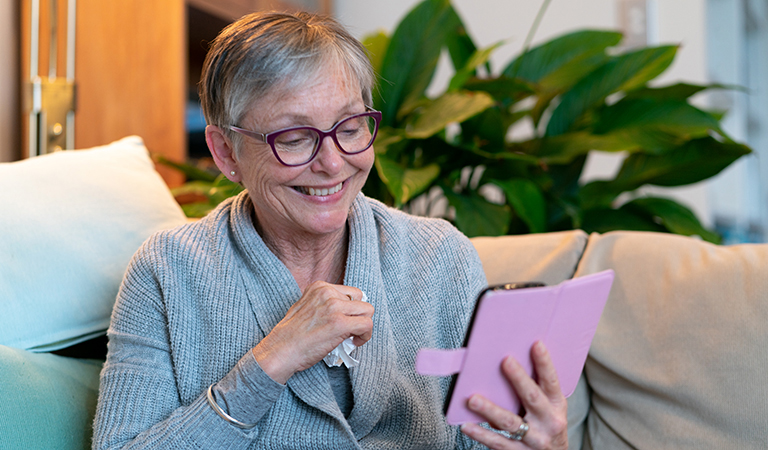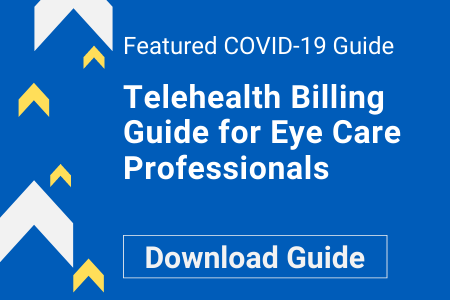
22 Apr Optometry Telehealth Connects Providers With Patients During COVID-19
During the pandemic coronavirus (COVID-19) healthcare crisis, many eye care practices have temporarily closed or reduced office hours and are only providing urgent and emergent procedures. To protect the health of employees and patients, practices are transitioning to using optometry telehealth (remote non-clinical) and telemedicine (remote clinical) services to connect with and provide remote care to patients.
A Jobson Research report says that 81.1 percent of the survey respondents offering telehealth and telemedicine are using phone-based consultations, and 78.6 percent are using image/video consultations. And 38.7 percent of patients are interested in accessing telehealth services.
Dr. Philip Gross is an optometrist with Vision Quest Eye Care Center (4-doctor, 2-location practice) in Delaware, who started using telehealth and telemedicine services during the coronavirus healthcare crisis. Dr. Gross shares how he and his partners found the right telehealth solutions and how they use telemedicine to triage urgent and emergency patient care during COVID-19.
How Telehealth Helps Optometrists Stay Connected with Patients
Why did your practice transition to offering telehealth services during the COVID-19 outbreak?
When the Centers for Disease Control and Prevention (CDC) recommended optometrists postpone routine eye care services, for the safety of our patients, doctors, staff, and our families, we complied with CDC guidelines by providing only emergency and urgent care in our office. Because we have to decide which patients to see in the office, we launched telehealth services that same day to assist with triaging patients and to provide remote care, especially for high-risk patients.
How easy was it to set up and implement a telemedicine plan? Which telehealth platforms do you use and why?
It was reasonably easy to set up a telehealth solution from the doctor’s side, but from the patient side, we quickly realized some telehealth platforms are easier than others. We use EyecareLive and Doxy.me, and both are HIPAA-compliant telemedicine solutions.
EyecareLive hosts a cloud-based portal that offers visual acuity testing and dry eye questionnaires. But it does require the patient to download an app to their iPhone or Android mobile devices, and our doctors must also be on a computer or laptop with video capabilities. EyecareLive does not have an app yet for the doctor’s side, but this is planned for the future.
Doxy.me is a simple solution and it does not require the patient to download anything. You can use the basic service for free with a personalized room URL. On the doctor’s side, it can be done from a notebook, computer, tablet, or mobile phone without an app. However, Doxy.me does not offer visual acuity or anything eye care specific.
Which types of telehealth services are you currently providing to your patients?
We offer optometry telehealth visits for patients complaining of redness, itching, burning, tearing, or eyelid conditions. Also, we use telehealth to check on our glaucoma patients who we may not see for a few months, or they are past due with an appointment. We can check compliance, ask if they need medication refills, and verify that they are not having side effects and no ocular complaints.
For macular degeneration patients, we make sure they are compliant with monitoring the Amsler grid, and if they are taking Age-Related Eye Disease Study (AREDS) supplements or something similar so they are also compliant.
This is a great time to connect with your patients who are in need of your help and show them you are available, care for them, and will help them in any way you can. It’s also a great time to make sure they are safe, social distancing as appropriate, and reminding them to watch local, state, and national recommendations to protect themselves and those around them.
If the new patient or existing patient has video capabilities, we do a telemedicine visit and bill the new patient as 9920x or an established patient as 9921x with modifier -95 and Place of Service (POS) 02. If the patient has no video capability and is an existing patient, then we use virtual check-in and bill G2012 with the POS as 02 and no modifier. However, as of March 30, 2020, the Centers for Medicare and Medicaid Services (CMS) now requires that you use POS 11 (where service is typically provided) for all Medicare telehealth/telemedicine services during the COVID-19 pandemic.
If the patient has no video capability and is a new patient then we cannot do any video visit or virtual check-in at this time. We will then determine if there is an urgent or emergency need to see the patient in our office, where we will follow CDC COVID-19 safety guidance. Safety measures also include wearing personal protective equipment (PPE) and using patient care supplies to ensure the safety of our staff and patients.
How are you using a secure patient portal to conduct e-visits?
If we have an established patient contact us by our HIPAA-compliant two-way communication patient portal, we can bill for the limited e-visit services using 99421–99423 codes. Our cloud-based patient portal integrates with our optometry EHR software (MaximEyes) and provides secure interactions with patients.
How does optometry EHR and practice management software help you with documenting telehealth services?
We are very careful in making sure to fully document the patient’s EHR encounter in MaximEyes EHR and also to make a note at the beginning of the chart that the patient has given us verbal consent to proceed with an optometry telehealth visit.
How are you using patient communication systems during COVID-19?
Solutionreach has been great as we’ve been pushing out notices and updates to patients on how to adapt to the changes in our office hours and procedures. We send out specific messages to high-risk patients and recommend telehealth services, and we determine if telehealth, virtual visit, or an emergency in-office visit is necessary.
Use Telehealth and Telemedicine Billing Codes, Modifiers and POS To Prevent Denied Claims
To help make the transition to billing and coding for optometry telehealth services easier, we’ve put together a free Telehealth Billing Guide for Eye Care Professionals During COVID-19. We recommend that you always verify with your biller or optometric billing consultant before you submit your telemedicine claims.
Telehealth Billing Tips:
- All health care providers must retain or have access to appropriate Medical Decision Making (MDM) documentation if requested for Medicare claims submitted to CMS.
- To ensure you are coding your eye care claims correctly, you must be diligent with Local Coverage Determinations (LCD), National Coverage Determinations (NCD), and Medicare Administrative Contractors (MAC) in your area. Also, sign up to receive payer listserv updates.
- Always verify the POS with your billers or billing services provider to avoid denied claims as some payers may require the POS as 02 versus 11, even though most payers generally follow Medicare’s lead.
What is the COVID-19 Telemedicine 1135 Waiver?
On March 17, 2020, CMS issued a Medicare Telemedicine Health Care Provider Fact Sheet that relaxes telehealth reimbursement rules as part of waiver 1135. As of March 6, 2020, Medicare will reimburse providers for more non–face-to-face telehealth services. This waiver will ensure that those patients who are at a higher risk for COVID-19 are still able to meet with their doctor from their home.
If informed consent is required for a telehealth service during the COVID-19 crisis, verbal consent is acceptable; however, you must document the consent in the patient’s medical record or EHR.
The Office for Civil Rights (OCR) at the Department of Health and Human Services (HHS) will waive penalties for HIPAA violations against health care providers that serve patients in good faith through everyday communications technologies, such as FaceTime, Skype, Zoom, Facebook Messenger video chat, or Google Hangouts video during the COVID-19 public health emergency. However, CMS recommends you inform your patients that these third-party applications are not HIPAA-compliant.
While waiver 1135 allows eye care providers flexibility during COVID-19, you must still remain compliant with protected health information (PHI) that was created in the processing of caring for the patient.
Our HIPAA Compliance Guide for Eye Care Professionals and The HIPAA Risk Assessment Checklist for Eye Care Professionals Guide reviews several steps you must take to protect the privacy and security of PHI.
FDA Issues Policy for Remote Ophthalmic Assessment and Monitoring Devices During COVID-19
In April 2020, the Food and Drug Administration (FDA) issued temporary voluntary and non-binding guidelines to “help expand the capability of remote ophthalmic assessment and monitoring devices to facilitate patient care while reducing patient and healthcare provider contact and exposure to COVID-19 during this pandemic.”
Diagnostic devices include visual acuity charts, visual field devices, general-use ophthalmic cameras, and tonometers. Download the FDA final guidance guide.
Telehealth and Telemedicine Industry Resources
- COVID-19 Resources Webinar IV: Update on Telehealth and COVID-19 (AOA): Medicare coding and reimbursement updates and resources.
- Guide to Telehealth-based Care During COVID-19 (AOA): This guide assists optometrists who may need to use telehealth services, including state law impacts, Medicare changes, and billing and codes.
- Coding for Phone Calls, Internet, and Telehealth Consultations (AAO): The American Academy of Ophthalmology (AAO) provides coding options for telehealth and communication-based technology service based on CMS guidelines.
- AOA Position Statement Regarding Telemedicine in Optometry (AOA): This updated policy statement (October 2020) was developed with input from leaders in eye health and vision care, artificial intelligence, telehealth platforms, and practicing physicians.
- Telehealth Guidance for Electronic Clinical Quality Measures for Eligible Professionals (CMS): Information relating to the allowance of telehealth encounters for the eligible professional/eligible clinician electronic clinical quality measures (eCQMs) used in CMS quality reporting programs for the performance period 2020.
- Medicare Coverage and Payment of Virtual Services Video (CMS): This video provides answers to common questions about the Medicare telehealth services benefit.
- Medicare Telehealth Services List (CMS): Download a list of services payable under the Medicare Physician Schedule.
- Telehealth Services Medicare Learning Network (CMS): Information about telehealth services, billing and payment, and helpful resources.
- Evaluation and Management (E/M) Services Guide (CMS): This Medicare Learning Network guide provides detailed information about common sets of codes, selecting codes, and other resources.
- Coronavirus Waivers and Flexibilities (CMS): Refer to this CMS web page for the latest news about the temporary 1135 waiver and other flexibilities during COVID-19.
- Congress Expands Telehealth Benefits for Medicare Beneficiaries (CMS): During the COVID-19 outbreak, CMS will temporarily pay clinicians who provide telehealth services to Medicare beneficiaries across the entire country.
- Medicare Telemedicine Health Care Provider Fact Sheet (CMS): March 17, 2020 fact sheet includes information on the expansion of the new telehealth 1135 waiver, and a summary of Medicare telemedicine services (includes HCPCS and CPT® codes).
- COVID-19 Resource Center (American Telemedicine Association): Resources, policy updates, tools and platforms, and recorded webinars.

Technology is always a huge investment, and you need to know that your investment is worth it. Rapid response time and long-term solutions are the foundations of the First Insight service model. Whether it’s optometry EHR and practice management solutions, ophthalmic cloud-based image management, or full-service optometric billing and RCM solutions, we help you resolve issues so you can focus all of your energy on treating patients.
See if MaximEyes is right for your optometry practice—request a demo today.
________________________________
It is the responsibility of the health care provider to ensure that they correctly submit claims. First Insight bears no responsibility or liability, and the information within this document was current at the time of posting. Medicare, Medicaid, and third-party insurance rules can change. CPT® is a registered trademark of the American Medical Association®.





